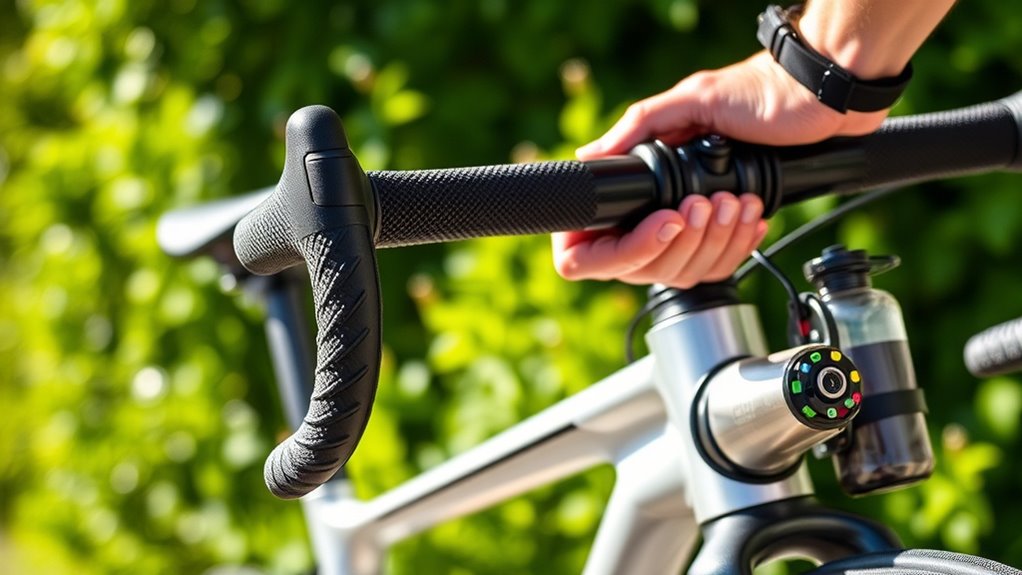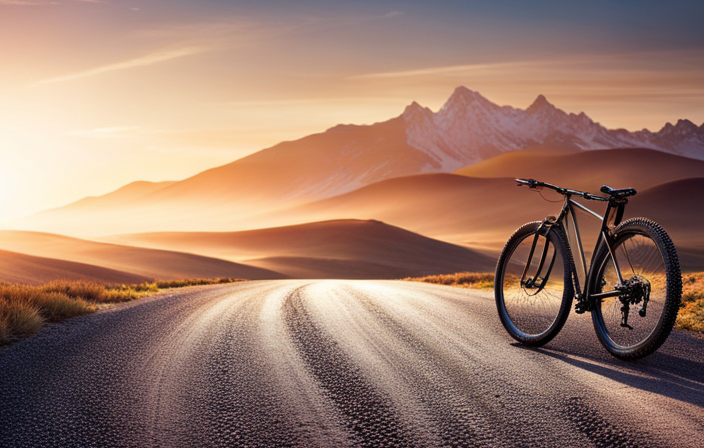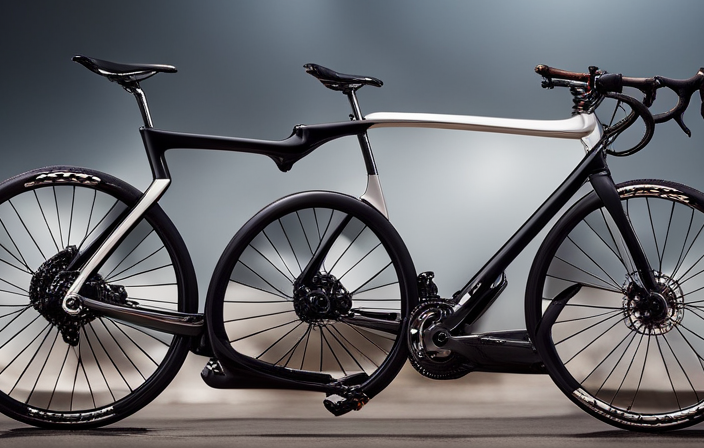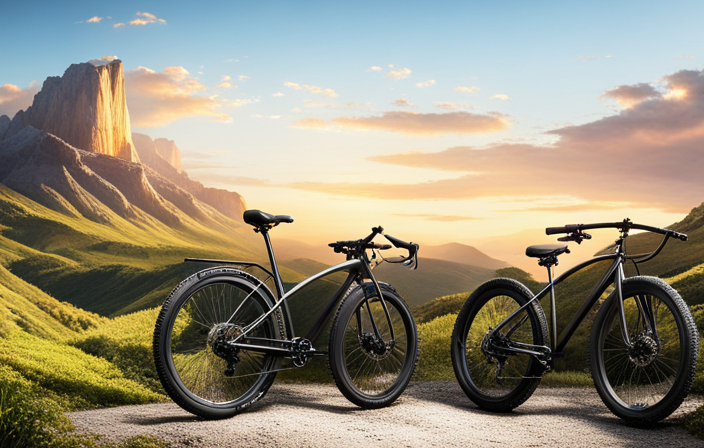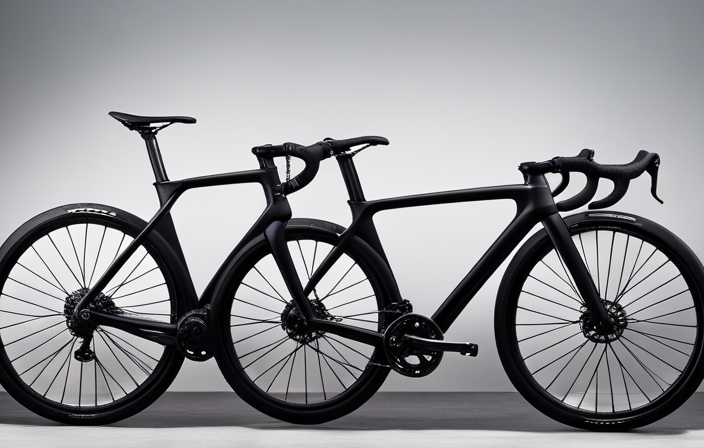For your first gravel race, pack hydration gear like water bottles or a hydration pack, plus snacks such as energy bars and gels. Bring essential repair tools including spare tubes, a multi-tool, and inflation devices. Dress in weather-appropriate layers—moisture-wicking base layers, insulating mid-layers, and waterproof outer layers. Choose a gravel-ready bike with wider tires and good gearing. Don’t forget navigation devices, safety items, and storage solutions for quick access. Learn more to prepare confidently!
Key Takeaways
- Use a gravel-specific bike with wider tires (≥35mm), disc brakes, and multiple gears for optimal performance and comfort.
- Pack hydration essentials like water bottles, hydration bladders, and electrolyte supplements to stay properly fueled.
- Include repair tools such as spare tubes, tire levers, multi-tools, and CO2 inflators for quick fixes on the trail.
- Wear weather-appropriate, layered clothing, including moisture-wicking base layers, insulating mid-layers, and waterproof outer layers.
- Carry navigation devices like GPS-enabled bike computers and pre-loaded routes to ensure accurate navigation and track progress.
Hydration and Nutrition Supplies
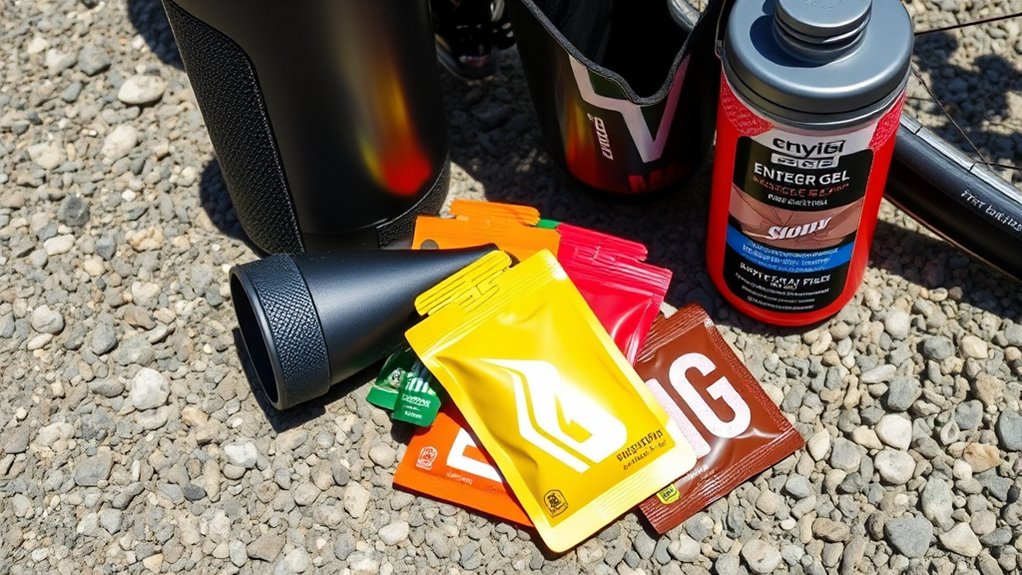
Staying properly hydrated and fueled is essential for maintaining your energy and performance during a long gravel race. Carry multiple water bottles or a hydration bladder to guarantee you stay hydrated over several hours. It’s important to drink consistently and include electrolyte supplements to replace salts lost through sweat, especially in hot conditions. To keep your energy levels steady, consume 30-60 grams of carbohydrates per hour through snacks, gels, or drinks. Pack a variety of portable, easily digestible snacks like energy bars, trail mix, dates, or nut butters to sustain your effort. Be sure to practice your hydration and nutrition strategy during training rides. This helps you find what works best for your body and prevents gastrointestinal issues during the race. Regularly monitoring your hydration levels can also help optimize your performance and prevent dehydration. Additionally, understanding proper fueling techniques can make a significant difference in your endurance and recovery. Incorporating lifestyle habits such as adequate sleep and stress management can further enhance your overall race performance. Maintaining awareness of your nutritional needs is crucial to ensure you’re adequately fueled before and after the race for optimal recovery. Being mindful of factors affecting hydration can help you adjust your intake based on weather conditions and exertion levels.
Repair and Maintenance Kit

A reliable repair and maintenance kit is essential to keep you moving on race day. Make sure it includes key tools, spare parts, and quick fix items that match your bike’s specs. Practicing how to use them beforehand will save you time and stress if issues arise during the race. Additionally, considering specific upgrades like performance chips can optimize your bike’s efficiency and responsiveness in race conditions. Incorporating AI-powered diagnostics can further help identify and address potential mechanical issues proactively. Being aware of common cheating strategies among competitors can also help you stay focused and competitive during the event. Remember, regular maintenance routines can prevent unexpected mechanical failures and enhance your overall performance.
Essential Repair Tools
Equipping yourself with a well-rounded repair and maintenance kit is essential for handling unexpected mechanical issues during your gravel race. A compact kit ensures you’re prepared for common problems. Key tools include:
- Spare inner tubes to quickly replace punctured tires.
- A multi-tool for quick adjustments and tightening bolts.
- A chain breaker to fix chain issues on the trail.
Having these items on hand minimizes downtime and keeps you moving. Additionally, carrying tire levers helps remove tires easily, while a tubeless plug kit can seal larger punctures. Keep spare bolts, cables, and a derailleur hanger in your bag for more serious repairs. Organize everything in a lightweight saddle or frame bag for easy access. Familiarize yourself with your tools beforehand to boost your confidence and readiness for any mechanical hiccup. Understanding bike anatomy and the importance of preparation can help you stay calm and focused during unexpected situations. Being aware of your gear setup can also improve your efficiency in making quick repairs. Furthermore, understanding family dynamics can assist in maintaining a positive mindset during race challenges. Incorporating an understanding of tips and tricks for bike maintenance can enhance your troubleshooting skills when time is limited.
Spare Parts List
Having a well-organized spare parts list is essential for quickly addressing mechanical issues during your gravel race. Your repair kit should include spare tubes, tire levers, a multi-tool, patch kit, and CO2 inflators for fast fixes on gravel roads. Carry extra chain links, quick links, and spare bolts for bottle cages and accessories to stay prepared for unexpected breakdowns. A tubeless plug kit and tyre boot are crucial for repairing punctures and preventing further tyre damage during long, technical sections. The size of your spare parts depends on race length and terrain complexity—longer and more challenging events demand more supplies. To keep everything accessible, store your spare parts in sealed, organized containers within your saddle or frame bag, protected from dirt and moisture. Using trusted custodians for your gear storage can also enhance the security and reliability of your spare parts during the race. Additionally, staying mindful of small mistakes that can happen during a race helps you maintain focus and adapt quickly to unforeseen issues, ensuring a smoother experience on the trail. Being aware of common mechanical failures can help you prepare more effectively and reduce race-day stress, especially when considering the importance of regular maintenance to prevent issues before they occur. Incorporating knowledge about sound vibrations and their healing effects can also inspire you to keep your gear in optimal condition, reducing the risk of failures caused by overlooked maintenance.
Quick Fix Strategies
When you’re out on the gravel course, quick and effective repair strategies can make the difference between finishing strong or facing a long walk. To handle unexpected mechanical issues, pack a repair kit with essential tools. First, keep tire levers handy to quickly remove tires and fix flats. Second, carry a multi-tool equipped with chain links, a chain breaker, and screwdrivers to handle most mechanical repairs. Third, always have a spare tube compatible with your rims and valves for fast tire replacements. Additionally, include CO2 cartridges with an inflator head or a mini pump for quick inflation. Store everything in an organized saddle or frame bag, so you can access your repair essentials swiftly when needed. Being prepared ensures you stay confident and ride on. Incorporating repair and maintenance skills into your prep can help you troubleshoot more effectively in the field. Proper knowledge of Glycolic Acid benefits can also enhance your skin’s resilience, keeping you comfortable during long rides.
Weather-Appropriate Clothing and Layers
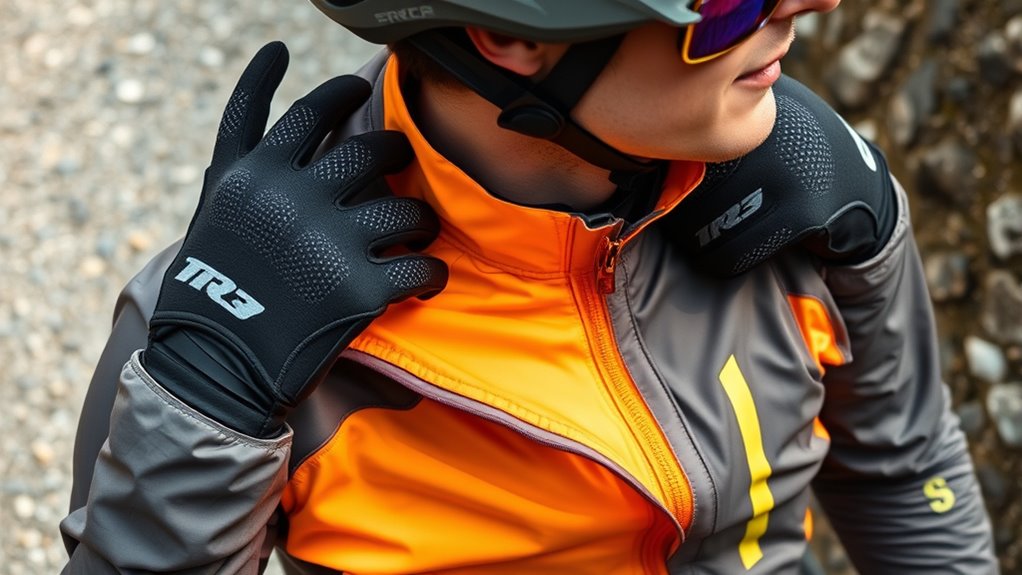
Adapting to changing weather conditions during a gravel race requires careful layering of your clothing. Start with moisture-wicking base layers to keep sweat away from your skin, preventing chafing. Add insulating mid-layers for warmth if needed, and top with waterproof outer layers like breathable Gore-Tex or eVent fabrics to shield you from rain and wind. A lightweight, packable rain jacket or vest is essential for sudden weather shifts. To visualize, consider this gear:
| Layer Type | Purpose |
|---|---|
| Moisture-wicking base | Keep sweat away, stay dry |
| Insulating mid-layer | Provide warmth in cold conditions |
| Waterproof outer | Protect against rain and wind |
| Extra accessories | Arm/leg warmers, thermal hats |
Proper clothing choices with quick-drying, moisture-management fabrics keep you comfortable and ready for any weather.
Bike and Gear Selection
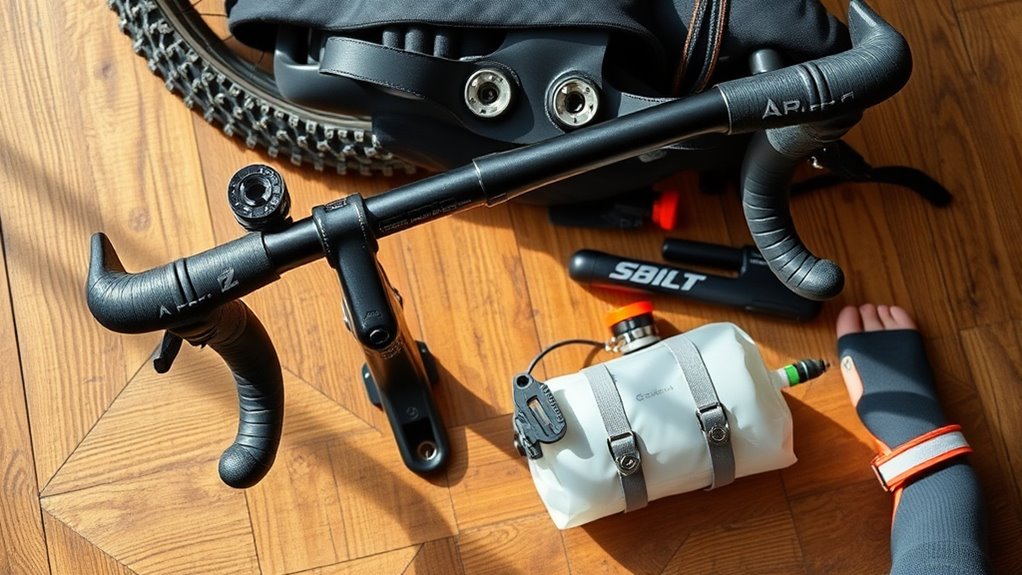
Choosing the right bike and gear sets the foundation for a successful gravel race. You’ll want a gravel-specific bike with wider tires, disc brakes, and multiple gears to handle different terrains. Additionally, selecting versatile components and accessories guarantees you stay comfortable and prepared throughout the race.
Choosing the Right Bike
Selecting the right gravel bike is crucial for a successful race, as it directly impacts your comfort, control, and ability to handle diverse terrains. When choosing your bike, consider these key points:
- Opt for a gravel bike with wider tires (at least 35mm) for better traction and comfort on loose surfaces.
- Select a model with multiple gear options, like 1x or 2x drivetrains, to easily tackle varied terrain and steep climbs.
- Prioritize bikes with reliable components, such as Shimano GRX or SRAM Rival, to ensure durability and ease of maintenance during the race.
Whether you prefer a lightweight carbon frame or a sturdy aluminum or steel option, focus on comfort and functionality. Picking the right gear and bike will set you up for success.
Essential Gear & Accessories
To guarantee you’re fully prepared for your first gravel race, gathering the right gear and accessories is key. Your bike should be a versatile gravel or adventure model with wider tires (at least 40mm) and suitable gearing to tackle mixed terrain. Equip it with tubeless-ready wheels and tires to minimize flats and boost comfort on rough surfaces. A mounted bike computer or GPS device is essential for navigation and performance tracking, helping you stay on course and monitor your data. Use a sturdy, accessible frame or top tube bag to keep essentials like snacks, tools, and a water bottle within easy reach. Remember to include a reliable water bottle in your packing list, and consider carrying extra hydration or packs for longer, hotter routes.
Navigation and Tracking Devices
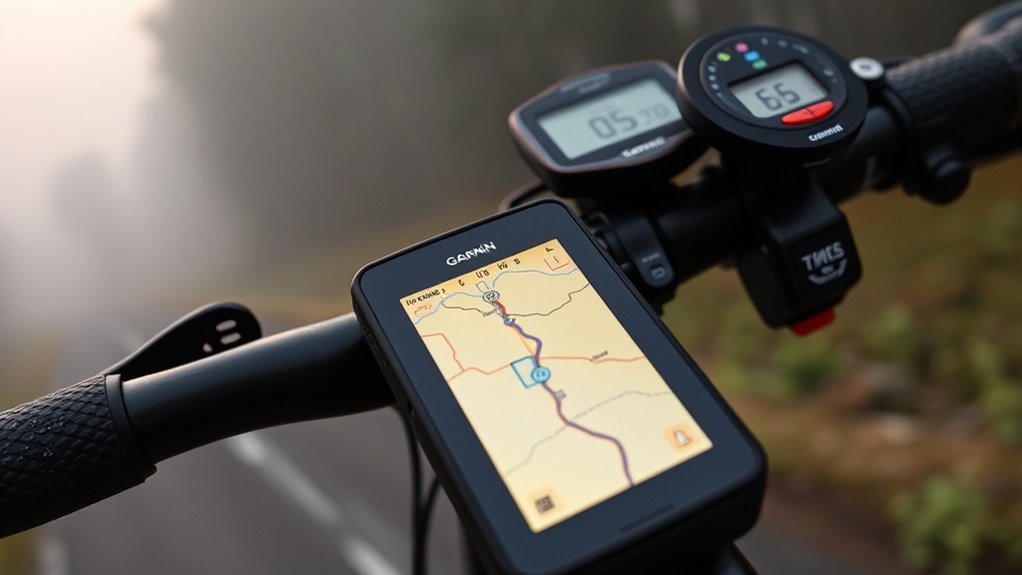
Navigation and tracking devices are essential tools to keep you on course and monitor your performance during a gravel race. A reliable bike computer with GPS, like the Garmin Edge 1040 Solar, offers precise navigation, route tracking, and real-time data to help you stay focused. To maximize their usefulness, consider these tips:
- Pre-load your route on apps like Strava or Komoot for seamless turn-by-turn navigation and easy adjustments.
- Use features like turn notifications, elevation profiles, and battery management to stay informed and powered throughout your ride.
- Carry an external power source or backup battery to extend device usage, especially for long or multi-day races.
These tools enhance your navigation, boost confidence, and improve post-ride performance analysis.
Safety and Emergency Equipment
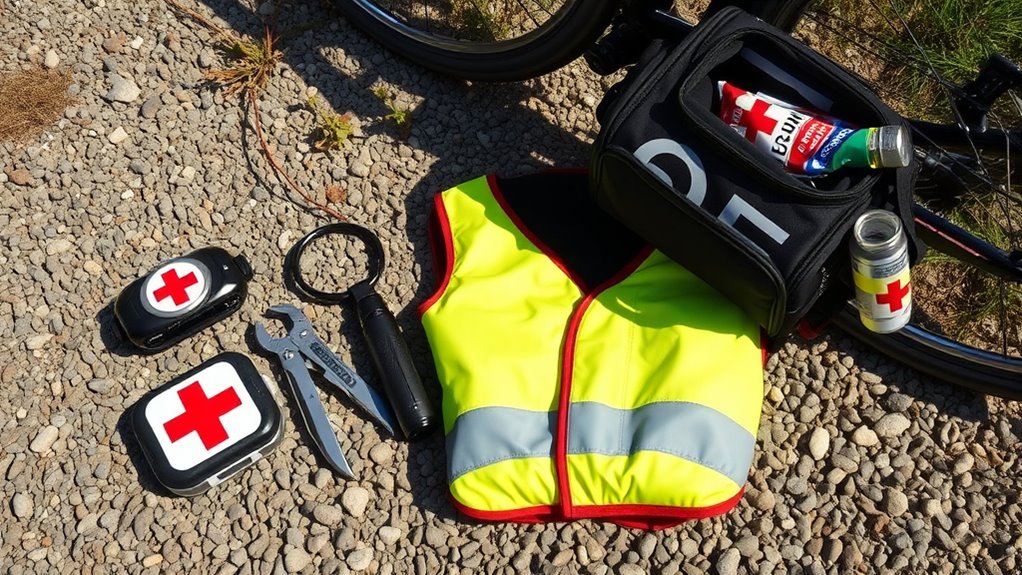
Staying safe and prepared can make all the difference when you’re out on a gravel course. Make sure to carry a compact first aid kit to handle minor injuries quickly. Your cell phone is essential—bring it with a backup battery, so you’re always connected, and include copies of your emergency contact info, like your driver’s license, health insurance card, or a Road ID bracelet. These details help first responders assist you faster if needed. Additionally, pack basic safety items such as a face mask for dust, hand sanitizer, sunscreen, and bug spray to stay comfortable and protected. Carrying cash and a credit card is smart for unexpected expenses or mechanical issues. Being prepared with this safety gear ensures you can handle emergencies confidently and focus on enjoying your race.
Storage Solutions for Easy Access

Having the right storage solutions can make a big difference in staying organized and efficient during your gravel race. Your bike shorts, jersey pockets, and saddle bag are key to accessible storage. Consider these options:
- Jersey Pockets – Perfect for quick access to energy gels, snacks, or a phone. They keep essentials within reach without disrupting your ride.
- Saddle Bag – Ideal for storing repair kits and personal items you don’t need frequently. It keeps your cockpit uncluttered and balances weight.
- Frame or Top Tube Bags – Offer quick access to navigation tools or small snacks and can hold larger items like spare clothes or extra nutrition without affecting handling.
Using a combination ensures organized access and even weight distribution, making your race smoother and more enjoyable.
Testing and Preparing Your Equipment
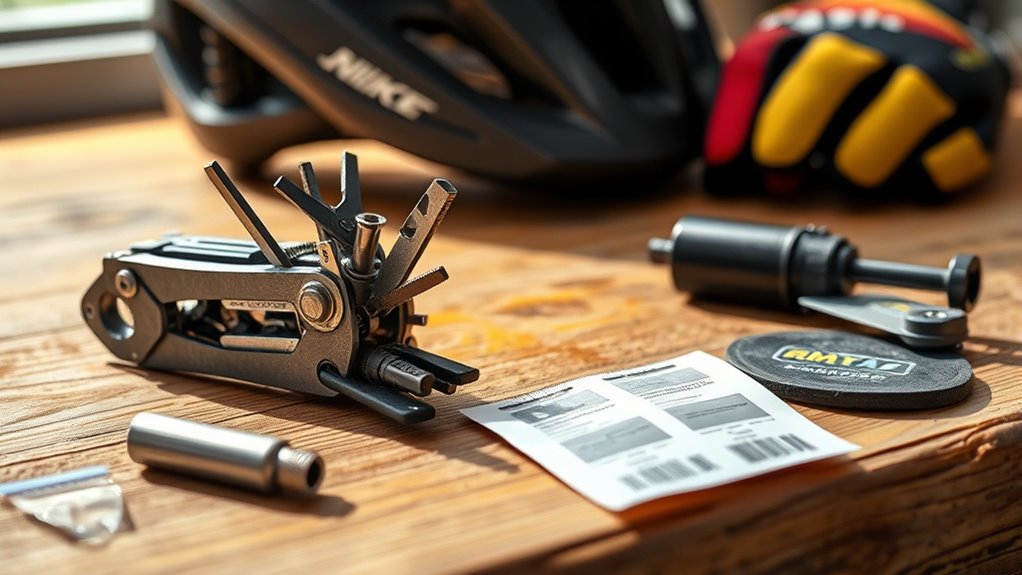
To guarantee your storage solutions work smoothly during the race, it’s essential to test and prepare your gear ahead of time. Conduct thorough testing of all equipment, including your bike, clothing, and repair kits, to confirm they function properly under race conditions. Simulate race scenarios during training rides to identify potential issues with fit, comfort, or mechanical reliability. Verify that your repair tools, spare parts, and hydration systems are working correctly and easily accessible in your storage solutions. Always test new gear and accessories on shorter rides first to prevent surprises on race day and ensure they meet your needs. Regular maintenance, such as inspecting and addressing any wear or damage, helps keep your gear in top condition and ready to perform when it counts.
Frequently Asked Questions
What Gear Do I Need for Gravel Biking?
When you ask what gear you need for gravel biking, think about staying hydrated, so carry water bottles or a hydration pack. Bring a repair kit with spare tubes, inflators, and tools, plus energy snacks to keep your energy up. Wear layered clothing for weather changes, and don’t forget safety gear like a GPS, phone, and emergency contacts. These essentials help you stay prepared, comfortable, and safe on your ride.
What Do I Need to Start Gravel Biking?
You need a reliable gravel bike that can handle rough terrain and varied surfaces, much like a sturdy vessel ready for adventure. Pair it with comfortable padded shorts and a good chamois to stay comfortable on long rides. Choose handlebars that suit your style, and always carry hydration. Don’t forget basic repair tools—spare tubes, pump, tire levers, and a multi-tool—so you’re prepared for unexpected mechanical issues.
How Do I Train for My First Gravel Race?
To train for your first gravel race, you should gradually increase your riding duration and intensity over several months, aiming for at least one long ride that surpasses the race distance. Incorporate interval training at race effort levels, practice on gravel terrain to improve handling, and develop a solid fueling routine. Cross-train with core or strength workouts to boost stability and prevent injuries, ensuring you’re well-prepared for race day.
What Accessories Do I Need for a Gravel Bike?
Think of your gravel bike as a trusted steed on a journey—your accessories are its armor and tools. You’ll need water bottles and cages to keep you hydrated, a repair kit for self-sufficiency, and storage options for snacks and essentials. Proper lighting guarantees visibility, while GPS, mudguards, and protective gear boost safety and comfort. These accessories arm you for a successful, confident ride through any terrain.
Conclusion
Getting your gear right for your first gravel race isn’t just about ticking boxes—it’s about setting yourself up for success. When you trust your equipment and prepare thoroughly, you create a rhythm that fuels confidence and minimizes surprises. Think of it like a well-oiled machine: each piece works in harmony, propelling you forward. So, double-check your gear, stay adaptable, and embrace the challenge—your best ride is just around the corner.
